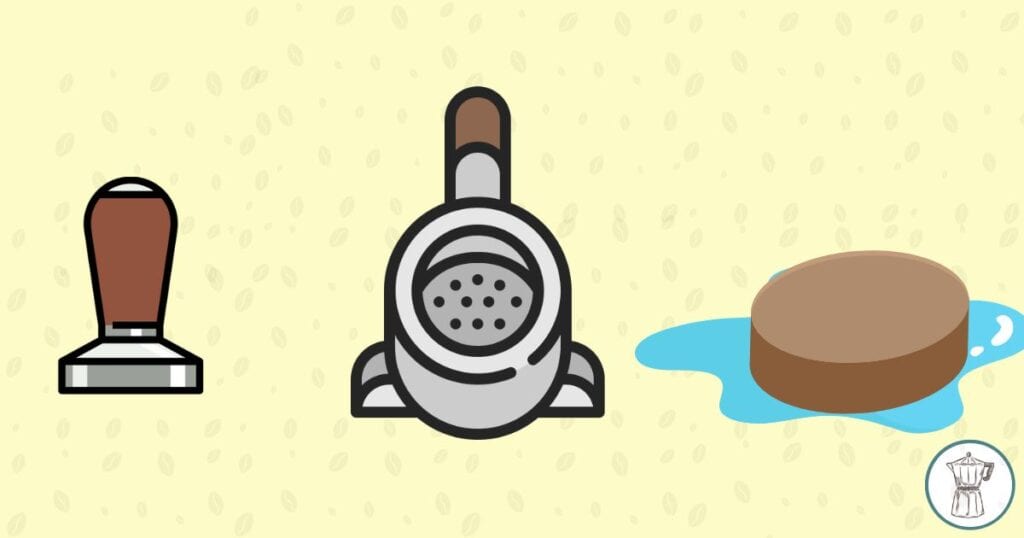‘Why is my espresso puck wet?’, I was wondering the other day when I brewed espresso.
What causes the espresso puck to get wet? Does it make coffee taste like rubber? Stick around, in this article I go over the possible reasons the espresso puck gets wet and share with you a bunch of tips and tricks along the way.
Let’s kick off.
Key takeaways:
- The main reasons that make your coffee puck wet
- How a puck wet directly affects the taste of your coffee
- What a perfect made espresso look and taste like every time
Why is my espresso puck wet?
One of the most common reasons that make an espresso puck wet is because there’s not enough ground coffee in the portafilter. Other reasons that turn your espresso puck wet are wrong grind size was used and tamping wasn’t done the right way.
Why a wet espresso puck is a problem?
Let’s get real, a wet espresso puck isn’t the end of the world, but the odds are you won’t drink the best espresso (it might be bad for you) you’ve ever had. Reason being, when the puck is wet it means there’s an issue somewhere along the process that practically means the water doesn’t extract the flavours from the coffee grounds. That’s why your coffee might be weak and watery.
Six reasons that make your espresso puck wet
Let’s go over the most common reasons that make your espresso puck wet.
1. Too coarse coffee grounds
If you used too coarse coffee grounds, the chances are that your espresso puck might be wet.
Like with every brewing gadget including a French press and Moka pot, an espresso machine has its own ideal grind size (and especially each manufacturer typically recommends the exact ground size). For example, if you want to brew with a French press you’ll need coarse coffee grinds whereas when you brew with a Moka pot you need to use medium-to-fine grounds.
What happens when you use coarse coffee grounds for your espresso machine?
In practice, the hot water runs through the coffee grinds quickly which results in a rather watery cup of coffee (obviously the water hasn’t extracted all the flavours from the coffee grounds). And as you might have guessed the espresso puck is going to be wet.
How can you fix it?
I have a question: are you using pre-ground coffee grounds?
Pre-ground coffee grounds are typically coarser than it’s stated on the package, meaning that you end up with a wet puck.
I suggest you look for a brand pre-coffee grounds that the manufacturer recommends and more specifically the exact grounds size they recommend for your exact brand model. This way you’ll brew with grinds closer to what’s needed.
Another solution to this issue is to just do the grinding yourself.
I know it’s more labour-intensive but at least you’ll be able to achieve the exact ground size that you aim for. All you need to do is invest in a coffee grinder (you can get a decent one for around $10-$20).
2. Not enough coffee grounds in the portafilter
This is another reason why the espresso puck gets wet.
If you didn’t put enough coffee in the portafilter, the hot water won’t find enough resistance and it will quickly run through the coffee grounds, meaning that the end result is going to be far from delicious coffee. In this case, make sure you stuff the portafilter with enough coffee grounds.
Also, consider opting for a new coffee basket that fits in more coffee grounds. The most popular dimension of a coffee basket is 58mm in diameter and fits around 21g of ground coffee. This way, you’ll be able to brew coffee that is richer.
3. Wrong way of tamping
Tamping the wrong way causes a wet espresso puck and coffee that tastes ‘mehh’.
What is the right way of tamping?
First off, make sure there are no loose coffee grounds after you’re done with the tamping. Ideally, the coffee grounds should look like a solid unit. This way the hot water finds resistance and it extracts the flavours and aromas from your coffee grounds evenly and you’ll be able to drink great coffee consistently.
Top tip: it’s wise to use a tamper that perfectly matches the size of your coffee basket, so you won’t leave any loose coffee grounds.

4. Unevenly distributed coffee grounds
That’s another reason, similar to the previous ones.
If you tamped your coffee grounds and there are unevenly distributed in the coffee basket, the chances are you’ll end up with a mucky espresso puck. What happens is when the water doesn’t find enough resistance, go through the coffee grounds the easiest possible way, and as a result ‘espresso channelling’ happens which in practice means the water extracts the flavours of just a tiny bit of the coffee grounds. This means that your espresso is probably going to have a different taste in every sip; some will taste strong coffee whereas others will just taste very weak coffee.
When distributing the coffee grounds in the portafilter your main aim should be to stuff them and tamp them in a way to create a solid unit.
One easy yet effective way to solve this issue is to use an espresso screen (preferably and metallic one). You just need to put it after on top of the coffee grounds after you’re done with the tamping.
5. Air pockets all over the place
As mentioned above tamping is important.
You don’t have to do it too abruptly and you need to press the coffee grounds steadily, so you don’t create air pockets. As you might have guessed, air pockets make the weather create espresso channeling and you end up with a tasteless cup of coffee.
Here’s a couple of tips from a coffee lover about wet coffee pucks:
Try and weight out 18g and try to get 36-38g back in 30seconds. Try not to clamp too hard either. Make sure you grind finer to increase time, because that little beast doesn’t have many setting you can play around with. Also, the puck will always come out wet. It has nothing to do with pulling the shot. Just make sure to clean the water spout after pulling every shot. Sometimes coffee grounds get stuck and can turn the coffee bitter. Also, I’d suggest that before pulling the shot. Let the water flow freely for around 2 seconds and then place the puck and pull the shot. I’ve found that this really helps with the increasing the balance and cleanliness of the shot.
– Different-Bed6274
6. Not enough temperature and pressure
It’s vital to get these 2 right.
If you don’t hit the ideal temperature and pressure (you guessed it) your espresso isn’t going to be good. If you think the temperature isn’t right, have a look at the thermostat of your machine to detect any issues. You can always reach out to the manufacturer and talk to them about the low temperature and pressure. And if the issue persists, it’s wise to hire a professional.
The table summarises the main reason why an espresso puck is wet:
| Reason: | Solution: |
| Your coffee grounds are too coarse | Consider grinding finer grounds |
| Not the write amount of coffee grounds in the portafilter | Make sure you read the instructions of your coffee machine to put the right amount of coffee in the portafilter |
| Unevenly coffee grounds | Ensure you tamped the coffee grounds evenly to make it easy for your machine to pull the espresso shot |
| Air pockets in the portafilter | Make sure your tamping is done right |
| Not enough temperature and pressure | Check the temperature and pressure of brewing every single time |
How should a great espresso look like?
Let’s go over a bunch of tips on how espresso should look after brewing:
- It needs to have the cream layer on top (it’s difficult to achieve this crema layer with a Moka pot due to its lower pressure)
- It should have a distinct aroma that makes you gulp it down
- It should be somewhat bitter (but it also depends on the coffee beans you use)
Let’s wrap it up
So do you know how why is your espresso puck wet? It’s good to know this kinda thing; it will certainly help you get a better understanding of the art and science of making coffee. And of course, you’ll be able to brew better coffee.

- How to Remove Coffee Stains From Countertop The Easy Way - December 21, 2023
- Can You Reuse Coffee Grounds in French Press? Truth Inside - December 12, 2023
- Can Expired Coffee Creamer Make You Sick? 3 Ways to Find Out - December 9, 2023
